“Still a Beacon”: Timmons Discusses Permitting, Immigration and More
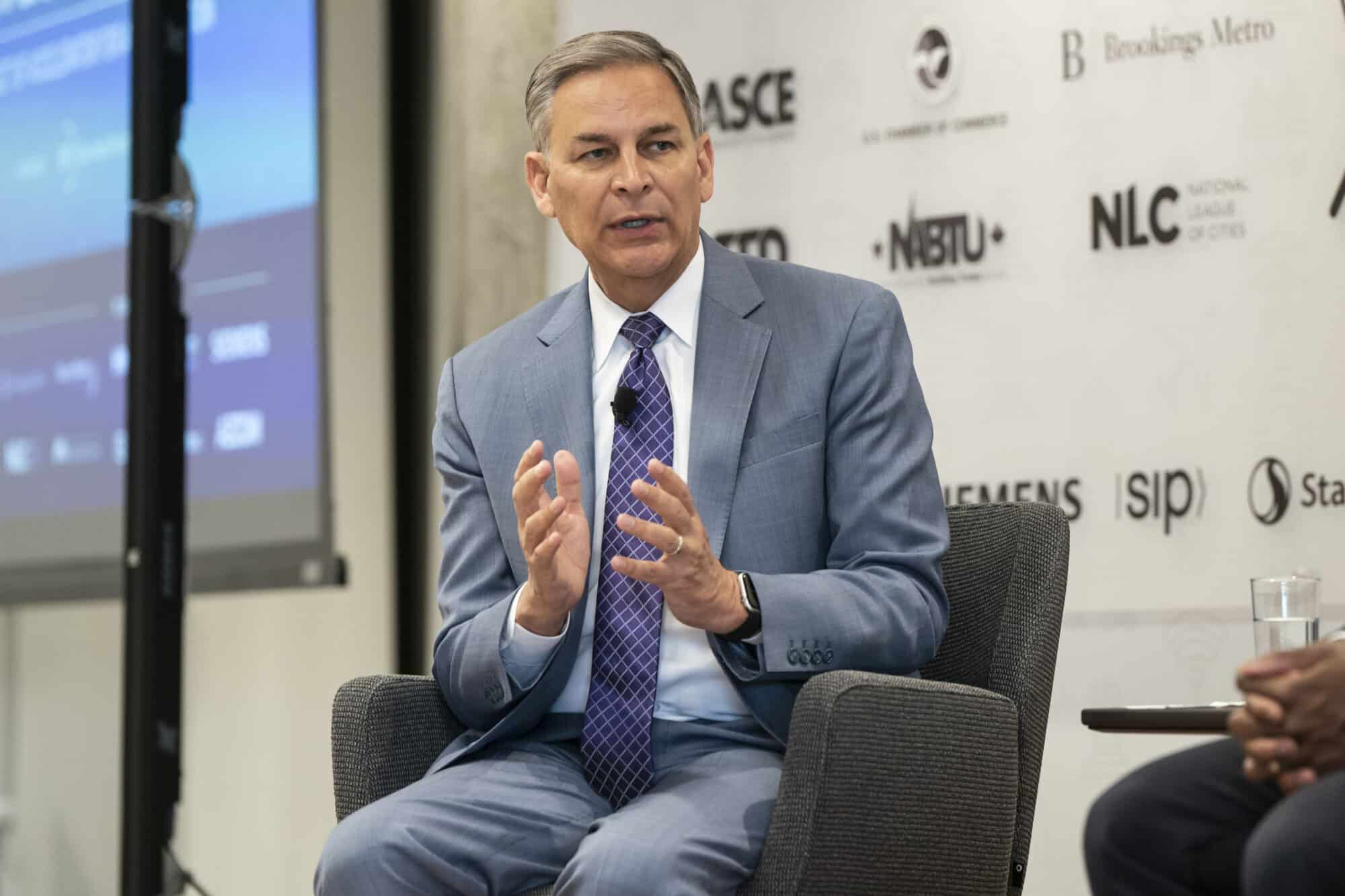
Streamlining the nation’s permitting process, filling open manufacturing positions and reforming the U.S. immigration system—these are just a few of the actions the U.S. must take improve American lives and to bolster the economy, NAM President and CEO Jay Timmons said Tuesday.
America still works: Timmons was one of three panelists at “Building the Workforce of Tomorrow Today,” an event hosted by United For Infrastructure, a program of Accelerator for America Action. He told audience members that manufacturers have before them “a great opportunity.”
- “What really excites me the most is, when you look at [the] CHIPS and Science [Act], when you look at [the] Infrastructure Investment [and Jobs Act] and when you look at—hopefully—permitting reform, what you see is, America still works,” he said.
- “We have this moment in time where I think we have to prove again to the world that America is a beacon, it is a democracy that provides opportunities for everyone and allows individuals to succeed and to rise on that ladder of success. …. For manufacturers, this is a great opportunity.”
Workforce challenge: Timmons discussed the primary workforce challenge before the sector—a projected growth of unfilled jobs—and how the NAM is aiming to overcome it.
- “We have about 800,000 open jobs in the sector today and … we have to hire 4 million people before 2030,” he said, referring to the findings from a joint study by the NAM’s 501 workforce development and education affiliate, the Manufacturing Institute, and Deloitte.
- The NAM and MI are seeking to fill those jobs through the work of several initiatives, Timmons continued. These include perception-changing programs such as Creators Wanted, the Toyota-founded Federation for Advanced Manufacturing Education program (now operated by the MI), Women Make America and the promotion of second chance hiring (employment of individuals with previous, non-violent involvement in the criminal-justice system).
Education: The importance of reaching the next generation of manufacturers early cannot be overstated, Timmons told the audience.
- He talked about the high-tech donations—robotics, CNC machines and more—by manufacturers to schools such as Rankin Technical College in St. Louis, Missouri, and Palatine High School in Palatine, Illinois. This machinery is used in programs that aim to interest students in manufacturing careers.
- “I think we have obligation to” make this sort of investment, Timmons said. “I’m very proud of our manufacturers for stepping up to it.”
Immigration: Perhaps the most pressing issue before the U.S., however, is immigration, Timmons told the audience.
- “Today, more so than ever before, we have an economic reality that we have to address,” said Timmons, who referenced the NAM’s policy blueprint on immigration reform, “A Way Forward,” during his talk.
- “We have what, 13 million undocumented folks in this country? … We need to hold our officials accountable for coming up with a plan that is workable and humane and will actually help the economy.”
What’s Going on with Title 42?

Title 42 has been a fixture in the news in recent days—but what is it and what does its recent end mean? We break it all down here.
What’s going on? Title 42, which went into effect March 2020, was a COVID-19-era policy that allowed the U.S. to expel migrants for health reasons. Under it, more than 2.6 million people were sent back to their home countries, according to The Washington Post (subscription).
- Now that Title 42 has concluded, authorities are only permitted to expel individuals using Title 8, pre-pandemic immigration rules, The New York Times (subscription)
What should we expect? Though an expected weekend “surge” in border crossings did not materialize—in fact, there was a 50% drop in the three days ending Monday, according to the Associated Press—“the number of crossings is still exorbitantly high, with U.S. Customs and Border Protection stopping more than 10,000 immigrants per day this week, the highest levels ever,” the Washington Examiner reports.
- And southern border communities remain on “high alert” for a potential near-term spike in migrant crossings, according to CNN.
How is the administration addressing the change? The Department of Homeland Security—which has issued a proposed rule on asylum—put out a six-pillar plan to address an influx of migrants at the southern border. The measures aim to:
- Increase resources, personnel, transportation and medical support and facilities;
- Bolster CBP processing efficiency;
- Move quickly to mitigate potential overcrowding of CBP stations and alleviate the burden on the surrounding border communities;
- Administer consequences for unlawful entry, including removal, detention and prosecution;
- Boost the capacity of nongovernmental organizations to take in migrants following processing by CBP, during the wait for results of their immigration removal proceedings;
- Target and disrupt the criminal organizations and smugglers that profit off vulnerable migrants and seek to move illegal drugs into the U.S.; and
- Collaborate with international and federal authorities to deter undocumented migration.
What’s Congress doing? The House passed a border package, the Secure the Border Act of 2023, the day Title 42 expired.
- The House measure—which the White House has said it would veto—“would mandate that Customs and Border Protection hire enough Border Patrol agents to maintain a staff of 22,000 and develop a plan to upgrade existing technology to make sure agents are well-equipped. It also would require the homeland security secretary to resume construction of the border wall,” according to NBC News.
- The Senate has two proposals to secure the border. One, by Sens. Thom Tillis (R-NC) and Kyrsten Sinema (I-AZ), would give the U.S. temporary authority to expel for two years migrants who try to enter illegally or without proper documents. The other, the Securing Our Border Act from Sen. Tim Scott (R-SC) and others, would fund “nonintrusive border inspections” and border-wall construction, as well as retention bonuses for CBP agents, and would end the current “catch and release” policy.
What’s the NAM doing? The NAM continues to advocate immigration reform through “A Way Forward,” its immediately implementable policy blueprint for legislators, meetings with key congressional leaders, member-story and news coverage (see here, here and here for a few examples), the Competing to Win Tour and more.
EPA’s Power Plant Rule a Grave Risk to Economy and Families
Manufacturers: The U.S. cannot afford to shut down more than half of our power generation and grind our economy to a halt.
Washington, D.C. – Following the release of the Environmental Protection Agency’s new rule on power plant emissions, National Association of Manufacturers Vice President of Energy and Resources Policy Brandon Farris released the following statement:
“Manufacturing in America is cleaner and more sustainable than ever, and the power generation sector has been making historic strides in bringing zero-emissions sources online. Even as that trend continues, this proposed regulation will prove unfeasible. With nearly 60% of our nation’s energy generated from natural gas and coal, this will either require deployment of still nascent technologies at an impractical pace or force those plants to shut down entirely. With the many threats to global energy security, that is a grave risk to our economy and to our families. The U.S. cannot afford to shut down more than half of our power generation and grind our economy to a halt. The NAM looks forward to working with the administration to ensure emissions standards protect public health while allowing manufacturers to continue pioneering technologies to make our air even cleaner and our climate even healthier.”
-NAM-
The National Association of Manufacturers is the largest manufacturing association in the United States, representing small and large manufacturers in every industrial sector and in all 50 states. Manufacturing employs nearly 13 million men and women, contributes $2.90 trillion to the U.S. economy annually and accounts for 55% of private-sector research and development. The NAM is the powerful voice of the manufacturing community and the leading advocate for a policy agenda that helps manufacturers compete in the global economy and create jobs across the United States. For more information about the NAM or to follow us on Twitter and Facebook, please visit www.nam.org.
ANALYSIS: New EPA Regulations Threaten at Least 852,100 Jobs and $162.4 Billion in Economic Activity
Manufacturers in the U.S. Are Leading the Way on Sustainability, Outpacing Global Competitors
Washington, D.C. – A new report conducted by Oxford Economics and commissioned by the National Association of Manufacturers warns that the Environmental Protection Agency’s proposed air quality regulations for particulate matter (PM2.5) are projected to threaten $162.4 billion to $197.4 billion of economic activity and put 852,100 to 973,900 current jobs at risk, both directly from manufacturing and indirectly from supply chain spending. In addition, growth in restricted areas may be constrained, limiting investment and expansion over the coming years. Due to these limited opportunities for expansion or investment, these areas in nonattainment could lose out on an additional $138.4 billion in output and 501,000 jobs through 2027.
Overall, the regulations could make it extraordinarily difficult to create new manufacturing jobs and protect existing manufacturing jobs in areas out of attainment. The regulations could also prevent much needed infrastructure improvements in these areas. This is because compliance with the regulations could require restricting manufacturing operations, resulting in fewer jobs, less investment and higher costs for consumers and families.
“Improving air quality in the U.S. is a top priority for manufacturers, and we’ve worked for years to make progress in delivering some of the cleanest manufacturing processes in the world,” said NAM President and CEO Jay Timmons. “This analysis makes clear these new regulations will weaken our ability to invest in the technology and processes that would continue to reduce emissions—while jeopardizing high-paying manufacturing jobs. We need to let manufacturers do what they do best: innovate and deploy modern technologies to protect the environment, while creating jobs and strengthening the economy.”
Key Findings:
- The regulations create a total economic exposure of $87.4 billion for manufacturing economic activity, equal to 2.4% of the U.S. manufacturing sector’s gross value added.
- The number of manufacturing jobs associated with this exposed activity is 311,600, or 1.9% of all U.S. manufacturing employment.
- Manufacturing in the U.S. exposed to the proposed standard supports between $75 billion and $110 billion in GDP and between 540,500 and 662,300 jobs in the U.S. through supply chain spending.
- Due to limits on expansion and investment, the proposed rule would put at risk approximately $138.4 billion of gross value added (in 2021 prices) and 501,000 jobs in 2027 in areas of nonattainment.
- Under the proposed rule, 200 counties could be placed out of attainment.
- California’s manufacturing sector will be most exposed, followed by Michigan and Illinois.
- Manufacturing operations in the U.S. are environmentally cleaner than the global average.
Find the latest information on the NAM’s efforts to oppose top-down air regulations, including statements from manufacturing leaders, here.
-NAM-
The National Association of Manufacturers is the largest manufacturing association in the United States, representing small and large manufacturers in every industrial sector and in all 50 states. Manufacturing employs nearly 13 million men and women, contributes $2.90 trillion to the U.S. economy annually and accounts for 55% of private-sector research and development. The NAM is the powerful voice of the manufacturing community and the leading advocate for a policy agenda that helps manufacturers compete in the global economy and create jobs across the United States. For more information about the NAM or to follow us on Twitter and Facebook, please visit www.nam.org.
NAM Fights SEC Buybacks Rule

Yesterday, the U.S. Securities and Exchange Commission finalized a rule that requires new disclosures from companies conducting stock buybacks.
The background: Stock buybacks are a commonplace practice that allow companies to ensure that their cash reserves are being used effectively. Returning capital to shareholders benefits both the company and its investors by increasing shareholder returns, enhancing capital formation and ensuring efficient capital allocation.
- Over the past few years, however, policymakers and regulators have taken steps to discourage buybacks, and the SEC has now finalized a rule targeting them.
The burden: The SEC’s rule imposes several new burdens on manufacturers conducting buybacks:
- A requirement that companies disclose detailed buyback data from each day of a fiscal quarter—imposing significant costs and dramatically increasing the complexity of businesses’ quarterly filings
- A requirement that companies provide disclosures justifying their buybacks, which could further politicize these capital allocation decisions
- New disclosures related to companies’ stock buyback programs and transactions by company management and boards of directors
The pushback: The NAM spoke out against the SEC’s rule when it was proposed last year, detailing the harm it would do to manufacturers.
- In particular, the NAM called on the SEC to reverse its proposed next-day disclosure requirement, which would have mandated upward of 250 new SEC filings per year for many public companies.
The result: Thanks to the NAM’s advocacy, the SEC’s final rule left out the daily disclosure requirement—a significant victory for manufacturers.
- However, companies will still be required to track daily buyback activity to comply with the quarterly day-by-day reporting mandate.
- In addition, the final rule maintained the proposal’s burdensome requirement that companies describe the “objectives or rationales” for any stock buybacks as well as the “process or criteria” used to set buyback targets.
The next steps: Most domestic companies will be required to provide daily buyback data in their Q4 2023 filings, meaning that daily tracking will begin in October 2023 and be reported to the SEC in early 2024. Most foreign companies will be required to comply in their Q2 2024 filings.
The last word: “The NAM is disappointed that the SEC has chosen to unjustifiably punish manufacturers for returning capital to their shareholders,” said NAM Managing Vice President of Tax and Domestic Economic Policy Chris Netram. “Manufacturers, investors, retirement plans and the entire economy benefit when companies can efficiently allocate capital via share repurchases.”
Further reading: The SEC rule is not the only action targeting buybacks in the past few years. The Inflation Reduction Act included a new tax on buybacks—which the NAM also opposed. It is currently engaging with the IRS to minimize the harm done to manufacturers by the tax. Read more here.
Manufacturers Call SEC Buybacks Rule a “Departure from Its Mission to Enhance Capital Formation and Protect Investors”
Washington, D.C. – Following the Securities and Exchange Commission’s decision to finalize its costly and unnecessary stock buybacks rule, National Association of Manufacturers Managing Vice President of Tax and Domestic Economic Policy Chris Netram released the following statement:
“The NAM is disappointed that the SEC has chosen to unjustifiably punish manufacturers for returning capital to their shareholders. Manufacturers, investors, retirement plans and the entire economy benefit when companies can efficiently allocate capital via share repurchases. The NAM was successful in convincing the SEC to abandon the most damaging aspect of its initial proposal, but the commission’s attempt to discourage these commonplace, commonsense transactions via an overly complicated, expensive and unworkable disclosure mandate is nevertheless a departure from its mission to enhance capital formation and protect investors.”
-NAM-
The National Association of Manufacturers is the largest manufacturing association in the United States, representing small and large manufacturers in every industrial sector and in all 50 states. Manufacturing employs nearly 13 million men and women, contributes $2.81 trillion to the U.S. economy annually and accounts for 55% of private-sector research and development. The NAM is the powerful voice of the manufacturing community and the leading advocate for a policy agenda that helps manufacturers compete in the global economy and create jobs across the United States. For more information about the NAM or to follow us on Twitter and Facebook, please visit www.nam.org.
Tax Change Throws a Wrench in Westminster Tool’s Operations
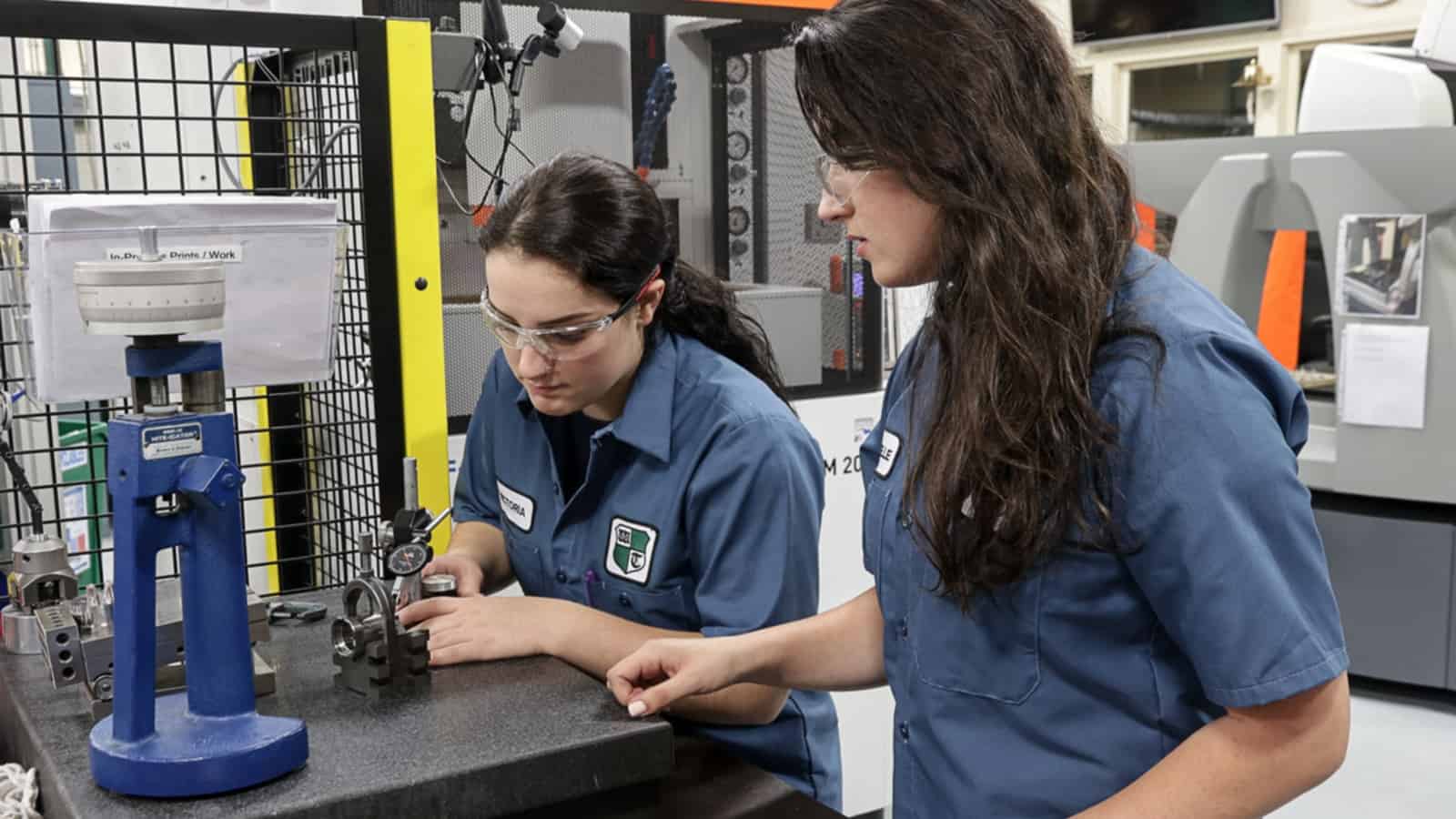
As a family-owned small business that works with giant, complex industries like aerospace and medical devices, Westminster Tool knows its ability to innovate is what sets it apart. The 25-year-old company makes complex injection mold systems, composite tooling and components—including devices used in medical transplants and high-performance plastic parts for military aircraft.
- “We’re constantly looking to improve ourselves,” said Westminster Tool Chief Financial Officer Colby Coombs. “We’re always looking to push technological advancements, bring products to market faster, improve quality and reduce cost.”
So when a harmful R&D tax change went into effect, it caused real problems for the Connecticut-based company.
The change: Until recently, businesses could deduct 100% of their R&D expenses in the same year they incurred the expenses. But since last year, the tax code has required businesses to spread their R&D deductions out over a period of five years, making it much more expensive upfront to invest in the kind of innovation at which Westminster Tool excels.
The impact: As a result of the policy shift, Westminster Tool has found itself paying significantly more in taxes—and having to scale back its ambitions.
- “The impact has been large,” said Coombs. “Because of this change, I had to reconsider a contract that was going to mean new jobs and diversification just based on the cash flow that I needed in order to pay the government.”
- “Ultimately, this law may prohibit me from hiring more people, training more people in new skills, investing in our community and bringing in new work stateside.”
The uncertainty: As a result of uncertainty, small businesses are being forced to hold off on investments they can no longer afford.
- “I am at the mercy of this law, waiting to see how it plays out before I can make any large-scale investment in our business,” said Coombs. “It is putting massive pressure on our ability to grow and be an employer of choice in our community.”
The urgency: Coombs also emphasized the international nature of the challenge. With so many global competitors—especially those based in China, which provides a super deduction for manufacturers—an inability to invest in R&D will hurt manufacturing in the U.S.
- “If Congress doesn’t do the right thing this year, this is going to be a job growth prohibitor or a job killer,” said Coombs. “We are trying to compete with international competitors that aren’t hamstrung by this problem. If Congress fails to fix this issue, it will drastically impact my ability to compete with the global powers in our industry.”
The small business effect: Coombs notes that small businesses in particular will be harmed by this change, since they don’t have the cash reserves to take on significant new expenses.
- “Small companies don’t have the balance sheets to handle this,” said Coombs. “We are doing the best we can to survive, to represent our state, to make advancements and offer the best job opportunities we can. This law is prohibiting me from doing what we’re striving to do.”
The last word: “Failure by Washington to reverse this change will put companies underwater and out of business,” said Coombs.
You can find more information and ways to take action at the NAM’s R&D Action Center.
Permitting Reform Would Unlock U.S. Potential, NAM tells Congress
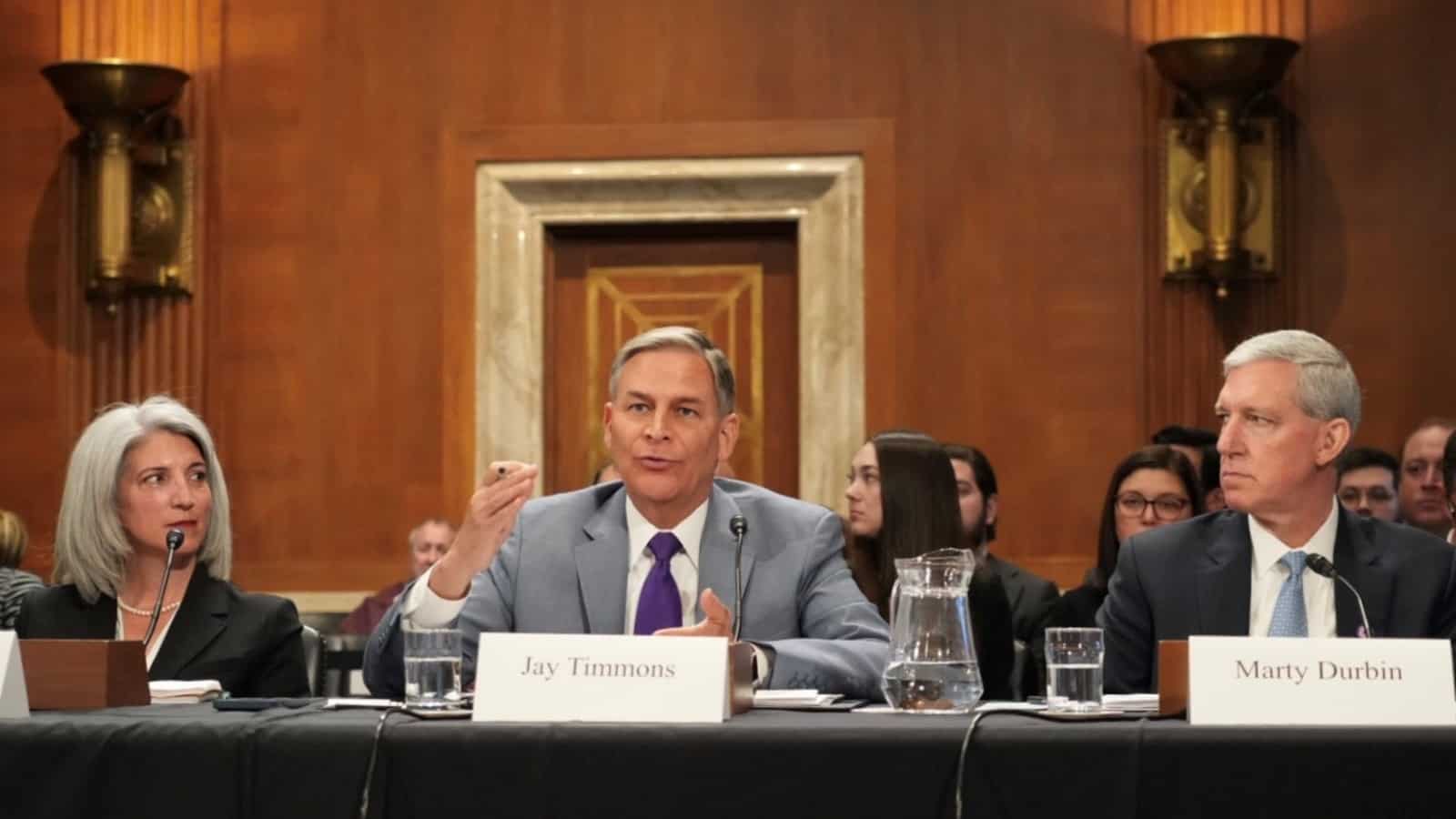
Reforming the permitting process for infrastructure projects could raise standards of living in America, unlock the full potential of ambitious recent legislation and make us less dependent on hostile foreign nations—all while making manufacturing in the U.S. more competitive, NAM President and CEO Jay Timmons told lawmakers yesterday.
What’s going on: Timmons gave testimony at “Opportunities to Improve Project Reviews for a Cleaner and Stronger Economy,” a hearing of the U.S. Senate Committee on Environment and Public Works, where he stressed the need to fix the needlessly time-consuming, complex permitting system.
- “For manufacturers, permitting reform is essential for our ability to compete in the global economy,” he said. “If we want more critical minerals for chip manufacturing, more domestic energy development and transport . . . more manufacturing facilities and jobs back home, better highways, bridges, airports [and] waterways, then we need permitting reform to make them a reality in the near future.”
Cut the wait: There is no reason for projects to take a decade or more to get approval, Timmons said.
- “If Washington could streamline the process—like manufacturers do in our businesses every single day—we could do more for this country,” Timmons continued, citing a White House Council on Environmental Quality report which found that environmental impact statements take an average of four-and-a-half years to complete.
- Timmons noted that in the case of one project, permits “from the U.S. Army Corps of Engineers were delayed a year due to the failure of the U.S. Fish and Wildlife Service to complete a required informal consultation under the Endangered Species Act.”
What to do: Timmons urged senators to work together to realize the following manufacturing priorities for permitting reform:
- Consolidated permitting processes with enforceable deadlines
- Fast approvals for transportation infrastructure projects
- A commitment to developing homegrown critical resources
- A moratorium on federal-agency regulations prior to the implementation of current standards
- Congressional assurance that lawmakers will hold the administration to recent and future statutory streamlining efforts
Protecting our values: Leaner, more efficient permitting and a commitment to sustainability and other American values can go hand in hand—and that’s exactly what manufacturers want, according to Timmons.
- “Manufacturers have a deep commitment to environmental stewardship, and we do not believe corners should be cut,” he said. “We believe in protecting our community, our neighbors and our environment. Reform is about . . . ensuring that this country—a democracy rooted in free enterprise—isn’t outpaced or outflanked or overtaken by nations that don’t share our values, don’t respect the environment or don’t recognize the dignity of human rights.”
Winton Machine CEO: Changes “Are Like a Tax on Manufacturing Growth”
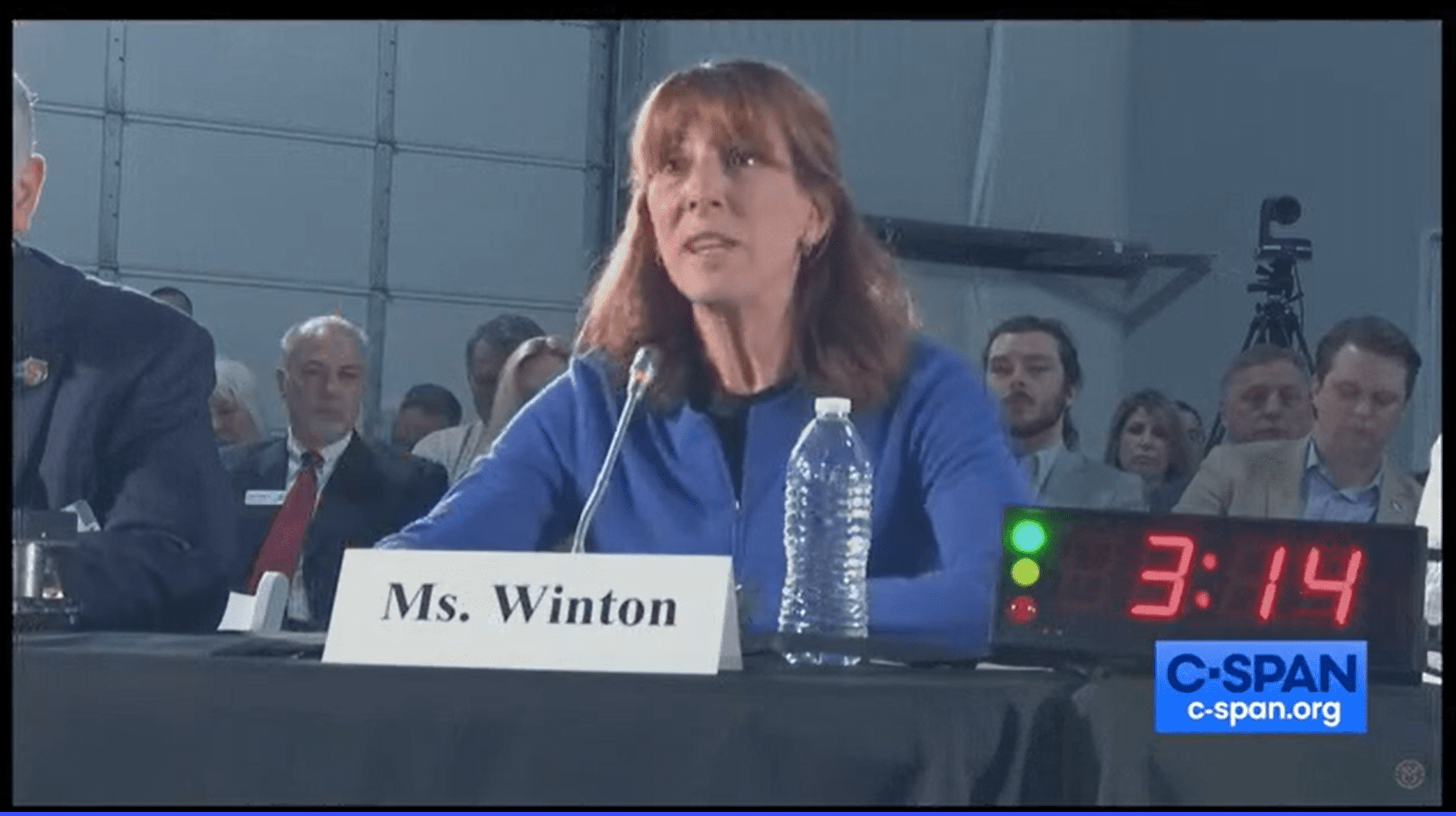
Recent changes to the U.S. tax code are threatening manufacturers’ continued success—and they need to be reversed now, Winton Machine Company CEO and NAM board member Lisa Winton told U.S. lawmakers at a recent hearing.
What’s going on: Winton, whose 25-year-old company designs and manufactures machines used in tubular part and coaxial cable fabrication, testified before the House Ways and Means Committee at a hearing last Friday on the state of the American economy.
- Winton spoke about the challenges facing manufacturers and highlighted the impact of two recent changes to the tax code that increase the cost of financing machinery purchases: the phaseout of immediate expensing and limitations on deductions for interest on business loans.
- “While I would like to double the size of my facility, the cost of doing so has risen fourfold over the last several years,” said Winton, whose business is one of approximately 244,000 small manufacturers in the U.S.
Why it’s important: “These changes are like a tax on manufacturing growth,” Winton said.
- Winton expressed concern that “these changes will force our customers to keep using older pieces of equipment, rather than purchasing newer or additional ones, or they will buy cheaper equipment from Asia.”
- In addition to these two harmful changes, Winton spoke about another recent revision requiring businesses to deduct or amortize their R&D expenses over a period of years. This makes R&D more expensive because businesses “can [now] only recover a small portion of those costs each year.”
- In sharp contrast to this treatment, China currently allows a “super deduction” for manufacturers, Winton noted.
More to come: There are more harmful changes on the way. The 20% pass-through deduction is set to expire in 2025, “at the same time that tax rates for pass-through entities like ours go up across the board,” Winton said.
- In addition, a scheduled change to the estate tax could force family-owned businesses to sell off pieces of their companies.
The last word: “None of these tax changes are fair to our employees, their families [or] our communities,” she said. “We need to fix them so we’re not making it harder to do business in America.”
NAM, Arizona Chamber Host Sinema for Immigration Panel
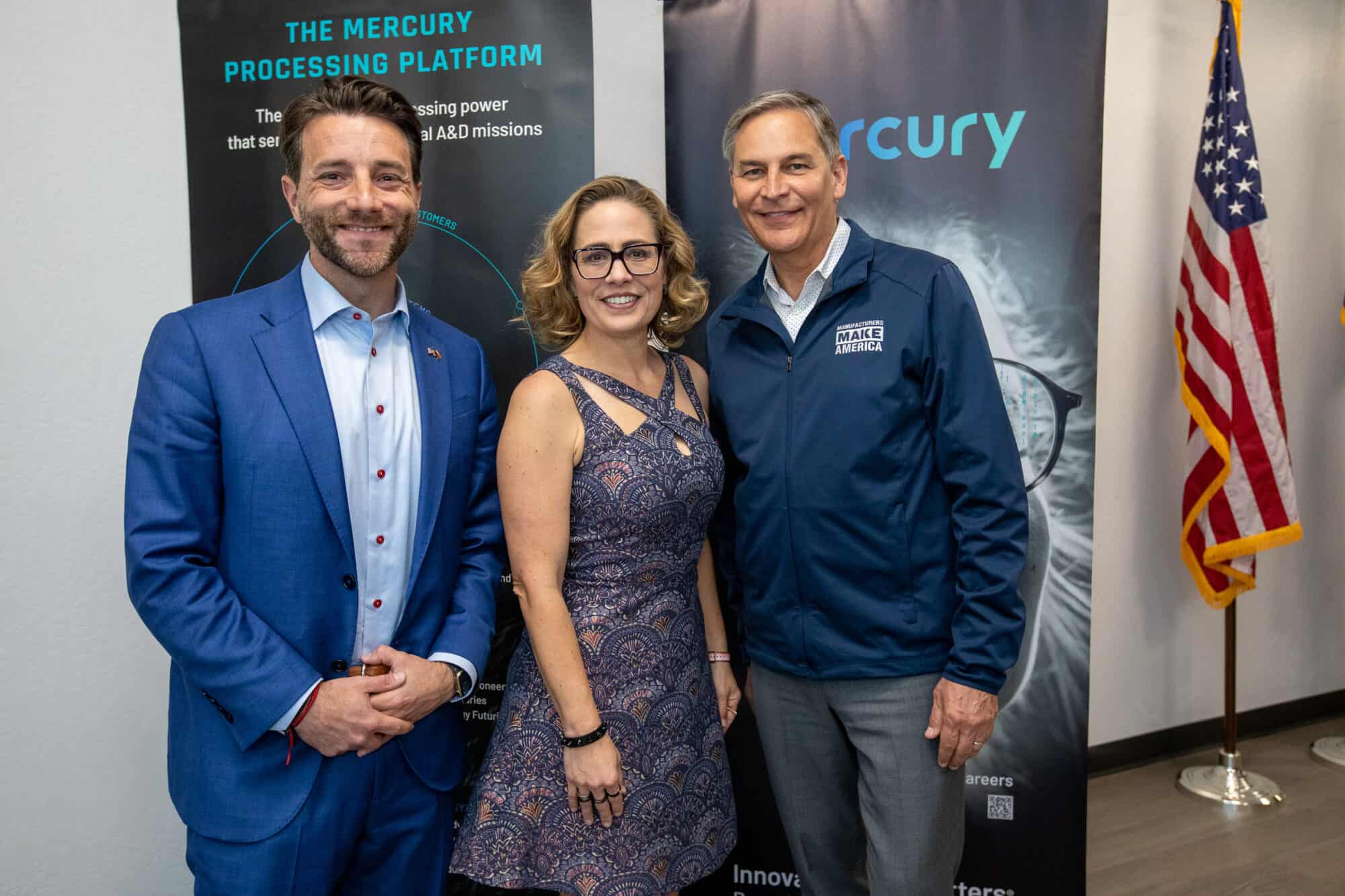
Immigration reform is an economic necessity—and it needs to happen now in order to spur economic growth and keep manufacturing in the U.S. competitive, NAM President and CEO Jay Timmons told an audience at a recent roundtable in Phoenix featuring Sen. Kyrsten Sinema (I-AZ).
- “Manufacturers want to build consensus,” Timmons said. “Most Americans agree that our immigration system is broken. And we need to fix it, whether it’s major legislation or targeted, specific fixes.”
What went on: The NAM and the Arizona Chamber of Commerce & Industry hosted Sinema last Friday for a discussion on fixing immigration policy and other matters critical to manufacturers.
- A seven-person panel—which included Valley Forge & Bolt CEO Michele Clarke and Intel Corporation State Government Relations Senior Director Jason Bagley—talked about the current challenges facing manufacturers and the urgent need for solutions on immigration, workforce development, tax policy and more.
- Held at the Phoenix facilities of defense-electronics company Mercury Systems, the roundtable was part of the NAM’s Competing to Win Tour, a facility-visit and discussion circuit that began in February. Its aim: to bolster manufacturing competitiveness through conversations between manufacturers, political and community leaders, employees and the media.
What needs fixing: “As I travel across Arizona, I hear from employers of all sizes about the challenges they face filling jobs,” Sinema told the audience of manufacturers and industry stakeholders. “This is especially true in the manufacturing sector. That is why I’ve been hard at work identifying realistic solutions.”
- Indeed, the workforce “problem isn’t going away,” added Timmons, who moderated the event. “We have nearly 700,000 open jobs right now. And 4 million manufacturing jobs will need to be filled by the end of the decade, 2.1 million of which could go unfilled if more people are not brought into the industry … according to research from Deloitte and the Manufacturing Institute, the NAM’s workforce development and education partner.”
How to fix it: Part of the solution is right in front of us, Timmons said.
- “There are many policy fixes that could build our pipeline of skilled employees—people who can excel in manufacturing positions while contributing to our society and building lives for themselves in America.”
- He referenced “A Way Forward,” the NAM’s policy blueprint featuring implementable action items for legislators on immigration reform and related issues, such as the undocumented population and green-card backlog.
NAM on the air: Timmons and Arizona Chamber CEO Danny Seiden were guests on Phoenix radio station KTAR News’ “Mike Broomhead Show” to discuss the Competing to Win tour and the importance of manufacturing jobs.
